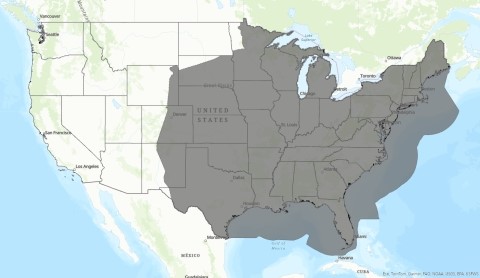The U.S. Fish and Wildlife Service (FWS) is currently developing new tools and guidance documents for the endangered northern long-eared bat (NLEB) and the proposed endangered tricolored bat (TCB). Occurring in more than half the country, the predominant threat to both species is the White Nose Syndrome (WNS), a deadly fungal disease affecting cave dwelling bats. Until a cure is available, FWS has identified both wind energy facilities and climate change as important factors affecting the viability of these bat species. The interim and proposed tools and guidance for wind energy facilities would dramatically affect the federal funding possibilities of distributed wind projects.

FWS Northern Long-eared Bat (NLEB) range for wind energy projects. Credit: Kathryn Bulliner, FWS.

FWS Tricolored Bat (TCB) range for wind energy projects. Credit: Kathryn Bulliner, FWS.
New wind installations of any size with ground disturbance seeking federal funding including, the USDA REAP grants, in the range of the bat species would be impacted by this FWS guidance. Per NEPA requirements, a federal agency like USDA is required to receive a determination from FWS prior to committing any federal funds. FWS, based on the state office’s interpretation of the guidance, could prevent a project from being funded or require operating under curtailment which would negatively impact the financial viability of a DW project. In the short term, some DWEA members have reported REAP application processing being stalled until the final FWS guidance is available. DWEA Board Members Padma Kasthurirangan, Steve Sherr, Paul Rowan, John Mogensen, and Mike Bergey worked with Executive Director Heather Rhoads to submit detailed comments for both bat species to FWS prior to the May 1 comment deadline. With DWEA Policy Director Lloyd Ritter’s help, the team met virtually with FWS Deputy Director Siva Sundaresan and his colleagues on June 20 and explained our industry’s concerns. The meeting was fruitful and we are hopeful that the final guidance, which should be available this summer, will reflect our recommendations.
